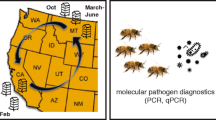Abstract
To evaluate symptoms, extent, and possible causes of colony decline and losses in Israel, we carried out (1) a survey of honeybee colony losses and potential causes via mail and phone; (2) systematic sampling of healthy and problematic beehives after requeening in the winter; (3) detection of Varroa and pathogens including, viruses and Nosema ceranae, by microbiological means and sensitive RT-PCR. From 58 beekeepers (46 000 colonies) interviewed, 40% complained of extensive colony loses during 2008. Examination and sampling for pests and pathogens of 113 hives in the winter of 2009 showed 35% of hives with Nosema and 21% with V. destructor. The most frequent viruses detected were Black Queen Cell Virus, Israeli Acute Paralysis Virus, and Deformed Wing Virus. A significant negative correlation was found between worker population in the hive and the presence of viral and Nosema infections.
Similar content being viewed by others
References
Benjeddou M., Leat N., Allsopp M., Davison S. (2001) Detection of acute bee paralysis virus and black queen cell virus from honeybees by reverse transcriptase PCR, Appl. Environ. Microbiol. 67, 2384–2387.
Berényi O., Bakonyi T., Derakhshifar I., Köglberger H., Nowotny N. (2006) Occurrence of six honeybee viruses in diseased Austrian apiaries, Appl. Environ. Microbiol. 72, 2414–2420.
Blanchard P., Olivier V., Iscache A.L., Celle O., Schurr F., Lallemand P., Ribière M. (2008) Improvement of RT-PCR detection of chronic bee paralysis virus (CBPV) required by the description of genomic variability in French CBPV isolates, J. Invertebr. Pathol. 97, 182–185.
Blanchard P., Ribière M., Celle O., Lallemand P., Schurr F., Olivier V., Iscache A.L., Faucon J.P. (2007) Evaluation of a real-time two-step RT-PCR assay for quantitation of Chronic bee paralysis virus (CBPV) genome in experimentally-infected bee tissues and in life, Appl. Environ. Microbiol. 73, 7711–7716.
Chen Y., Pettis J.S., Feldlaufer M.F. (2005) Detection of multiple viruses in queens of the honey bee Apis mellifera L., J. Invertebr. Pathol. 90, 118–121.
Chen Y.P., Siede R. (2007) Honey bee viruses, Adv. Virus Res. 70, 33–80.
COLOSS: http://coloss.org/.
Cox-Foster D.L., Conlan S., Holmes E.C., Palacios G., Evans J.D., Moran N.A., Quan P.L., Briese T., Hornig M., Geiser D.M., Martinson V., vanEngelsdorp D., Kalkstein A.L., Drysdale A., Hui J., Zhai J., Cui L., Hutchison S.K., Simons J.F., Egholm M., Pettis J.S., Lipkin W.I. (2007), A metagenomic survey of microbes in honey bee colony collapse disorder, Science 318, 283–287.
Guzmán-Novoa E., Eccles L., Calvete Y., Mcgowan J., Kelly P.G., Correa — Benítez A. (2010) Varroa destructor is the main culprit for the death and reduced populations of over wintered honey bee (Apis mellifera) colonies in Ontario, Canada, Apidologie, in press, DOI: 10.1051/apido/2009076.
Efrat H., Slabezki (2007) Bees’ hidden death, Colony Collapse disorder (CCD), Yalkut Hamichveret (in Hebrew) 47, 22–24.
EFSA (European Food Safety Agency) (2008) A report by the Assessment Methodology Unit in response to Agence de Securite Sanitaire des Aliments (AFSSA): Bee Mortality and bee surveillance in Europe, The EFSA J. 154, 1–28.
Giray T., Kence M., Oskay D., Ali Döke M., Kence A. (2010) Scientific note: colony losses survey in Turkey and causes of bee deaths, Apidologie (in press), DOI: 10.1051/apido/2009077.
Gregory P.G., Evans J.D., Rinderer T., de Guzman L. (2005) Conditional immune-gene suppression of honeybees parasitized by Varroa mites, J. Insect Sci. 5, 7.
Herbert E.W., Witherell P.C., Bruce W.A., Shirnanuki H. (1989) Evaluation of six methods of detecting Varroa mites in beehives, including the experimental use of acaricidal smokes containing fluvalinate or arnitraz, Am. Bee J. 129, 605–608.
Higes M., Martin-Hernández R., Botias C., Garrido Bailon E., Gonzalez-Porto A.V., Barrios L., Nozal M.J.D., Bernal J.L., Jimenez J.J., Garcia Palencia P., Meana A. (2008) How natural infestation by Nosema ceranae causes honeybee colony collapse, Environ. Microbiol. 10, 2659–2669.
Higes M., Martin-Hernández R., Garrido-Bailón E., González-Porto A.V., García-Palencia P., Meana A., del Nasal M.J., Mayo R., Bernal J.L. (2009) Honeybee colony collapse due to Nosema ceranae in profesional apiaries, Environ. Microbiol. R. 1, 110–113.
Maori E., Tanne E., Sela I. (2007) Reciprocal sequence exchange between non-retro viruses and hosts leading to the appearance of new host phenotypes, Virology 362, 342–349.
Martin-Hernández R., Meana A., Prieto L., Martinez Salvador A., Garrido-Bailón E., Higes M. (2007) Outcome of colonization of Apis mellifera by Nosema ceranae, Appl. Environ. Microbiol. 73, 6331–6338.
Navajas M., Migeon A., Alaux C., Martin-Magniette M., Robinson G., Evans J., Cros-Arteil S., Crauser D., Le Conte Y. (2008) Differential gene expression of the honey bee Apis mellifera associated with Varroa destructor infection, BMC Genomics 9, 301.
Oliver R. (2009) N. ceranae: kiss of death or much ado about nothing, Am. Bee J. 149, 759–764.
Ongus J.R., Peters D., Bonmatin J.M., Bengsch E., Vlak J.M., van Oers M.M. (2004) Complete sequence of a picorna-like virus of the genus Iflavirus replicating in the mite Varroa destructor, J. Gen. Virol. 85, 3747–3755.
Stolz D., Shen X.-R., Boggis C., Sisson G. (1995) Molecular diagnosis of Kashmir bee virus infection, J. Apic. Res. 34, 153–160.
Topolska G., Gajda A., Hartwig A. (2008) Polish honey bee colony-loss during the winter of 2007–2008, J. Apic. Sci. 52, 95–104.
van Engelsdorp D., Hayes Jr. J., Underwood R.M., Pettis J. (2008) A survey of Honey Bee Colony losses in the US, Fall 2007 to spring 2008, Plos One 3, e4071, 1–6. www.plosone.org.
van Engelsdorp D., Evans J.D., Saegerman C., Mullin C., Haubruge E., Nguyen B.K., Frazier M., Frazier J., Cox-Foster D., Chen Y., Underwood R.M., Tarpy D.R., Pettis J. (2009) colony collapse disorder: a descriptive study, Plos One 4, e6481, 1–16. www.plosone.org.
Yang X., Cox-Foster D.L. (2005) Impact of an ectoparasite on the immunity and pathology of an invertebrate: evidence for host immunosuppression and viral amplification, Proc. Natl. Acad. Sci. USA 102, 7470–7475.
Author information
Authors and Affiliations
Corresponding author
Additional information
Manuscript editor: David Tarpy
Rights and permissions
About this article
Cite this article
Soroker, V., Hetzroni, A., Yakobson, B. et al. Evaluation of colony losses in Israel in relation to the incidence of pathogens and pests. Apidologie 42, 192–199 (2011). https://doi.org/10.1051/apido/2010047
Received:
Revised:
Accepted:
Published:
Issue Date:
DOI: https://doi.org/10.1051/apido/2010047




